Understanding Adversity On Childhood Development Report 2022
VerifiedAdded on 2022/08/28
|11
|2910
|15
AI Summary
Contribute Materials
Your contribution can guide someone’s learning journey. Share your
documents today.
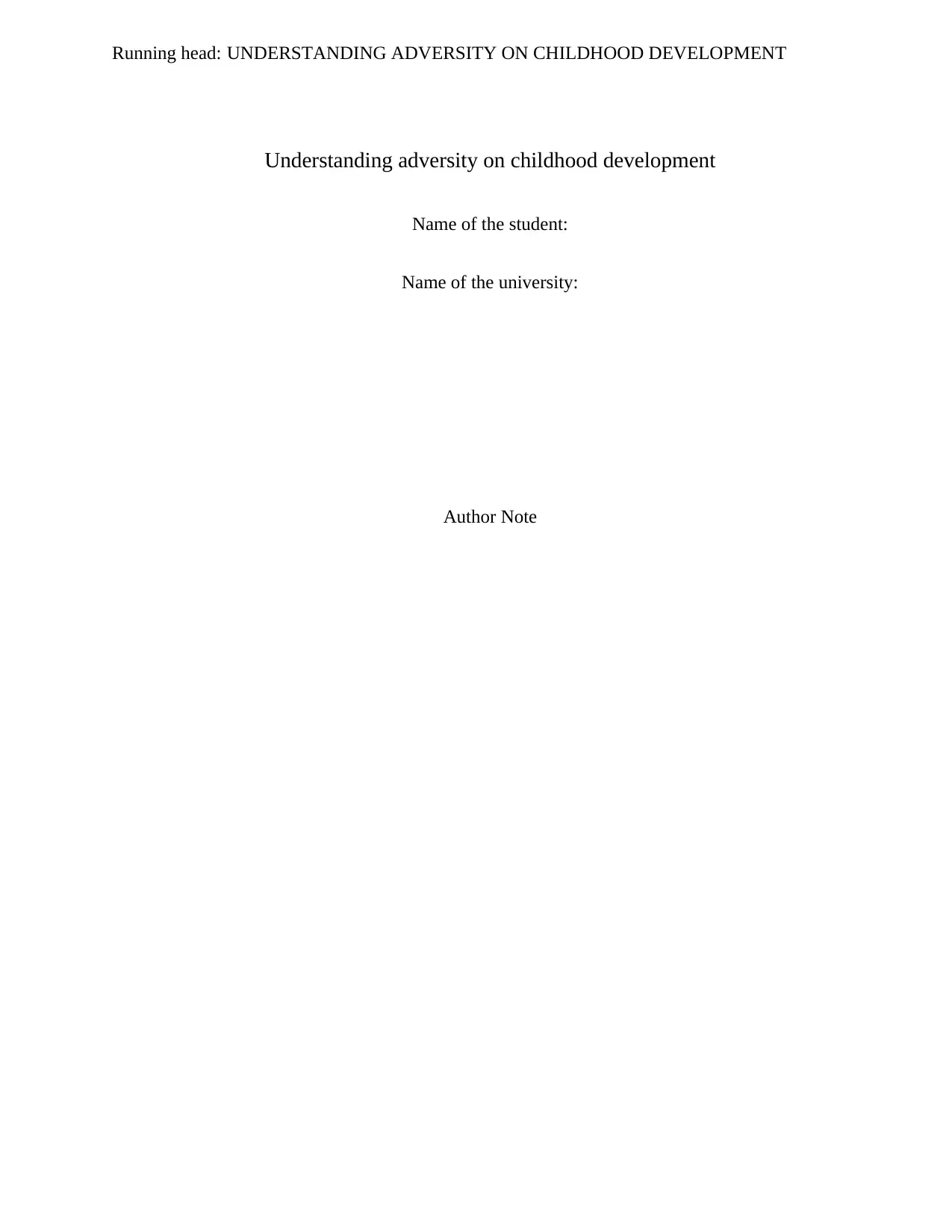
Running head: UNDERSTANDING ADVERSITY ON CHILDHOOD DEVELOPMENT
Understanding adversity on childhood development
Name of the student:
Name of the university:
Author Note
Understanding adversity on childhood development
Name of the student:
Name of the university:
Author Note
Secure Best Marks with AI Grader
Need help grading? Try our AI Grader for instant feedback on your assignments.
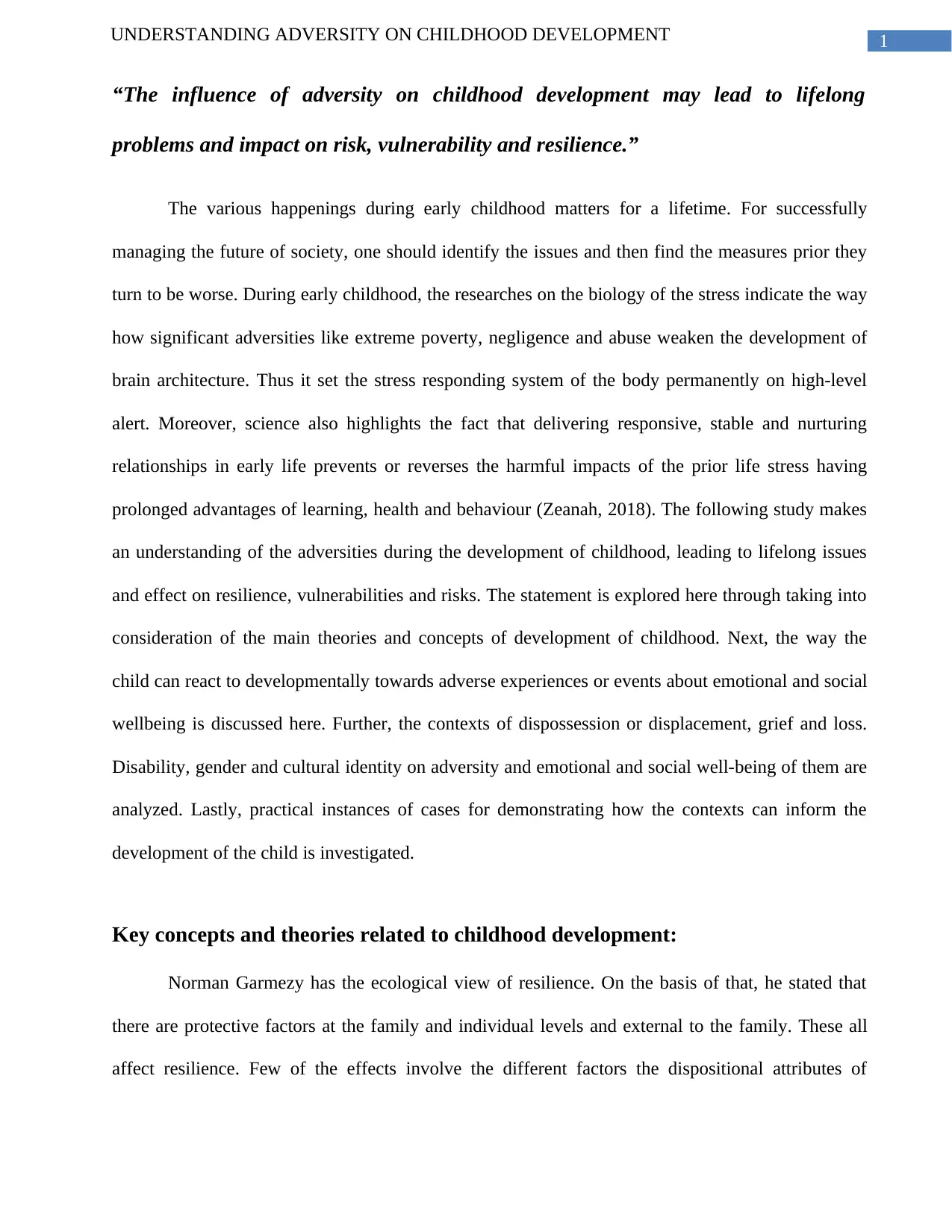
1UNDERSTANDING ADVERSITY ON CHILDHOOD DEVELOPMENT
“The influence of adversity on childhood development may lead to lifelong
problems and impact on risk, vulnerability and resilience.”
The various happenings during early childhood matters for a lifetime. For successfully
managing the future of society, one should identify the issues and then find the measures prior they
turn to be worse. During early childhood, the researches on the biology of the stress indicate the way
how significant adversities like extreme poverty, negligence and abuse weaken the development of
brain architecture. Thus it set the stress responding system of the body permanently on high-level
alert. Moreover, science also highlights the fact that delivering responsive, stable and nurturing
relationships in early life prevents or reverses the harmful impacts of the prior life stress having
prolonged advantages of learning, health and behaviour (Zeanah, 2018). The following study makes
an understanding of the adversities during the development of childhood, leading to lifelong issues
and effect on resilience, vulnerabilities and risks. The statement is explored here through taking into
consideration of the main theories and concepts of development of childhood. Next, the way the
child can react to developmentally towards adverse experiences or events about emotional and social
wellbeing is discussed here. Further, the contexts of dispossession or displacement, grief and loss.
Disability, gender and cultural identity on adversity and emotional and social well-being of them are
analyzed. Lastly, practical instances of cases for demonstrating how the contexts can inform the
development of the child is investigated.
Key concepts and theories related to childhood development:
Norman Garmezy has the ecological view of resilience. On the basis of that, he stated that
there are protective factors at the family and individual levels and external to the family. These all
affect resilience. Few of the effects involve the different factors the dispositional attributes of
“The influence of adversity on childhood development may lead to lifelong
problems and impact on risk, vulnerability and resilience.”
The various happenings during early childhood matters for a lifetime. For successfully
managing the future of society, one should identify the issues and then find the measures prior they
turn to be worse. During early childhood, the researches on the biology of the stress indicate the way
how significant adversities like extreme poverty, negligence and abuse weaken the development of
brain architecture. Thus it set the stress responding system of the body permanently on high-level
alert. Moreover, science also highlights the fact that delivering responsive, stable and nurturing
relationships in early life prevents or reverses the harmful impacts of the prior life stress having
prolonged advantages of learning, health and behaviour (Zeanah, 2018). The following study makes
an understanding of the adversities during the development of childhood, leading to lifelong issues
and effect on resilience, vulnerabilities and risks. The statement is explored here through taking into
consideration of the main theories and concepts of development of childhood. Next, the way the
child can react to developmentally towards adverse experiences or events about emotional and social
wellbeing is discussed here. Further, the contexts of dispossession or displacement, grief and loss.
Disability, gender and cultural identity on adversity and emotional and social well-being of them are
analyzed. Lastly, practical instances of cases for demonstrating how the contexts can inform the
development of the child is investigated.
Key concepts and theories related to childhood development:
Norman Garmezy has the ecological view of resilience. On the basis of that, he stated that
there are protective factors at the family and individual levels and external to the family. These all
affect resilience. Few of the effects involve the different factors the dispositional attributes of
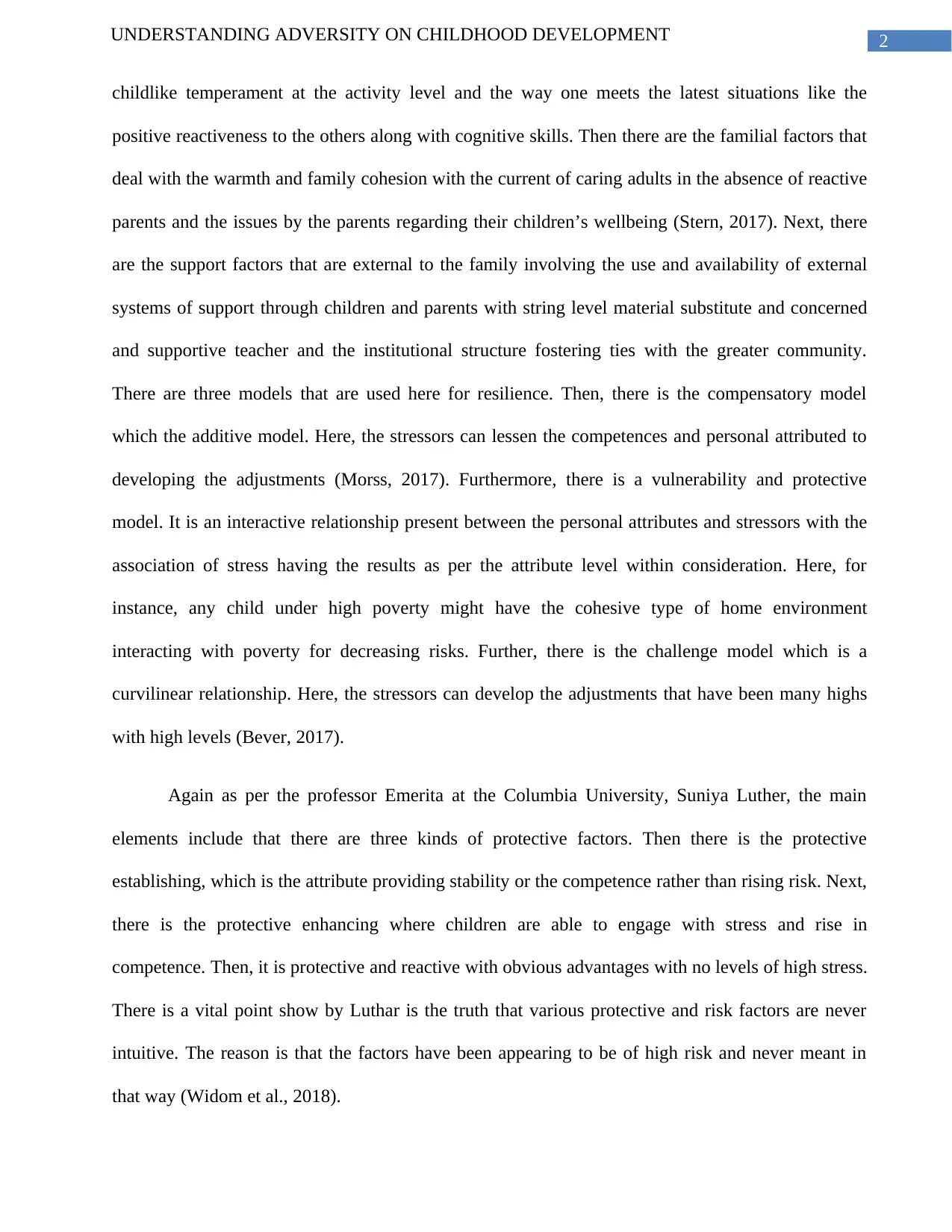
2UNDERSTANDING ADVERSITY ON CHILDHOOD DEVELOPMENT
childlike temperament at the activity level and the way one meets the latest situations like the
positive reactiveness to the others along with cognitive skills. Then there are the familial factors that
deal with the warmth and family cohesion with the current of caring adults in the absence of reactive
parents and the issues by the parents regarding their children’s wellbeing (Stern, 2017). Next, there
are the support factors that are external to the family involving the use and availability of external
systems of support through children and parents with string level material substitute and concerned
and supportive teacher and the institutional structure fostering ties with the greater community.
There are three models that are used here for resilience. Then, there is the compensatory model
which the additive model. Here, the stressors can lessen the competences and personal attributed to
developing the adjustments (Morss, 2017). Furthermore, there is a vulnerability and protective
model. It is an interactive relationship present between the personal attributes and stressors with the
association of stress having the results as per the attribute level within consideration. Here, for
instance, any child under high poverty might have the cohesive type of home environment
interacting with poverty for decreasing risks. Further, there is the challenge model which is a
curvilinear relationship. Here, the stressors can develop the adjustments that have been many highs
with high levels (Bever, 2017).
Again as per the professor Emerita at the Columbia University, Suniya Luther, the main
elements include that there are three kinds of protective factors. Then there is the protective
establishing, which is the attribute providing stability or the competence rather than rising risk. Next,
there is the protective enhancing where children are able to engage with stress and rise in
competence. Then, it is protective and reactive with obvious advantages with no levels of high stress.
There is a vital point show by Luthar is the truth that various protective and risk factors are never
intuitive. The reason is that the factors have been appearing to be of high risk and never meant in
that way (Widom et al., 2018).
childlike temperament at the activity level and the way one meets the latest situations like the
positive reactiveness to the others along with cognitive skills. Then there are the familial factors that
deal with the warmth and family cohesion with the current of caring adults in the absence of reactive
parents and the issues by the parents regarding their children’s wellbeing (Stern, 2017). Next, there
are the support factors that are external to the family involving the use and availability of external
systems of support through children and parents with string level material substitute and concerned
and supportive teacher and the institutional structure fostering ties with the greater community.
There are three models that are used here for resilience. Then, there is the compensatory model
which the additive model. Here, the stressors can lessen the competences and personal attributed to
developing the adjustments (Morss, 2017). Furthermore, there is a vulnerability and protective
model. It is an interactive relationship present between the personal attributes and stressors with the
association of stress having the results as per the attribute level within consideration. Here, for
instance, any child under high poverty might have the cohesive type of home environment
interacting with poverty for decreasing risks. Further, there is the challenge model which is a
curvilinear relationship. Here, the stressors can develop the adjustments that have been many highs
with high levels (Bever, 2017).
Again as per the professor Emerita at the Columbia University, Suniya Luther, the main
elements include that there are three kinds of protective factors. Then there is the protective
establishing, which is the attribute providing stability or the competence rather than rising risk. Next,
there is the protective enhancing where children are able to engage with stress and rise in
competence. Then, it is protective and reactive with obvious advantages with no levels of high stress.
There is a vital point show by Luthar is the truth that various protective and risk factors are never
intuitive. The reason is that the factors have been appearing to be of high risk and never meant in
that way (Widom et al., 2018).
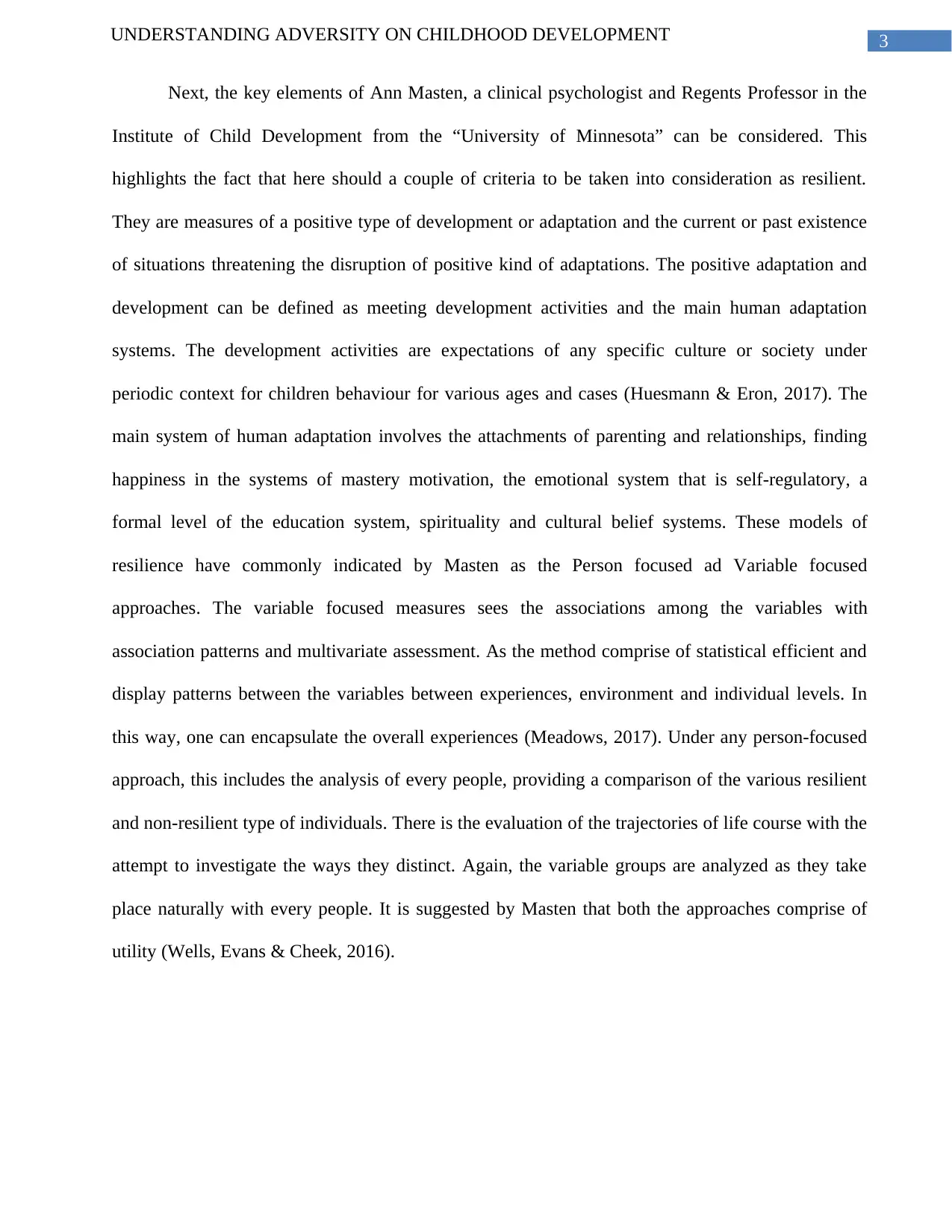
3UNDERSTANDING ADVERSITY ON CHILDHOOD DEVELOPMENT
Next, the key elements of Ann Masten, a clinical psychologist and Regents Professor in the
Institute of Child Development from the “University of Minnesota” can be considered. This
highlights the fact that here should a couple of criteria to be taken into consideration as resilient.
They are measures of a positive type of development or adaptation and the current or past existence
of situations threatening the disruption of positive kind of adaptations. The positive adaptation and
development can be defined as meeting development activities and the main human adaptation
systems. The development activities are expectations of any specific culture or society under
periodic context for children behaviour for various ages and cases (Huesmann & Eron, 2017). The
main system of human adaptation involves the attachments of parenting and relationships, finding
happiness in the systems of mastery motivation, the emotional system that is self-regulatory, a
formal level of the education system, spirituality and cultural belief systems. These models of
resilience have commonly indicated by Masten as the Person focused ad Variable focused
approaches. The variable focused measures sees the associations among the variables with
association patterns and multivariate assessment. As the method comprise of statistical efficient and
display patterns between the variables between experiences, environment and individual levels. In
this way, one can encapsulate the overall experiences (Meadows, 2017). Under any person-focused
approach, this includes the analysis of every people, providing a comparison of the various resilient
and non-resilient type of individuals. There is the evaluation of the trajectories of life course with the
attempt to investigate the ways they distinct. Again, the variable groups are analyzed as they take
place naturally with every people. It is suggested by Masten that both the approaches comprise of
utility (Wells, Evans & Cheek, 2016).
Next, the key elements of Ann Masten, a clinical psychologist and Regents Professor in the
Institute of Child Development from the “University of Minnesota” can be considered. This
highlights the fact that here should a couple of criteria to be taken into consideration as resilient.
They are measures of a positive type of development or adaptation and the current or past existence
of situations threatening the disruption of positive kind of adaptations. The positive adaptation and
development can be defined as meeting development activities and the main human adaptation
systems. The development activities are expectations of any specific culture or society under
periodic context for children behaviour for various ages and cases (Huesmann & Eron, 2017). The
main system of human adaptation involves the attachments of parenting and relationships, finding
happiness in the systems of mastery motivation, the emotional system that is self-regulatory, a
formal level of the education system, spirituality and cultural belief systems. These models of
resilience have commonly indicated by Masten as the Person focused ad Variable focused
approaches. The variable focused measures sees the associations among the variables with
association patterns and multivariate assessment. As the method comprise of statistical efficient and
display patterns between the variables between experiences, environment and individual levels. In
this way, one can encapsulate the overall experiences (Meadows, 2017). Under any person-focused
approach, this includes the analysis of every people, providing a comparison of the various resilient
and non-resilient type of individuals. There is the evaluation of the trajectories of life course with the
attempt to investigate the ways they distinct. Again, the variable groups are analyzed as they take
place naturally with every people. It is suggested by Masten that both the approaches comprise of
utility (Wells, Evans & Cheek, 2016).
Secure Best Marks with AI Grader
Need help grading? Try our AI Grader for instant feedback on your assignments.
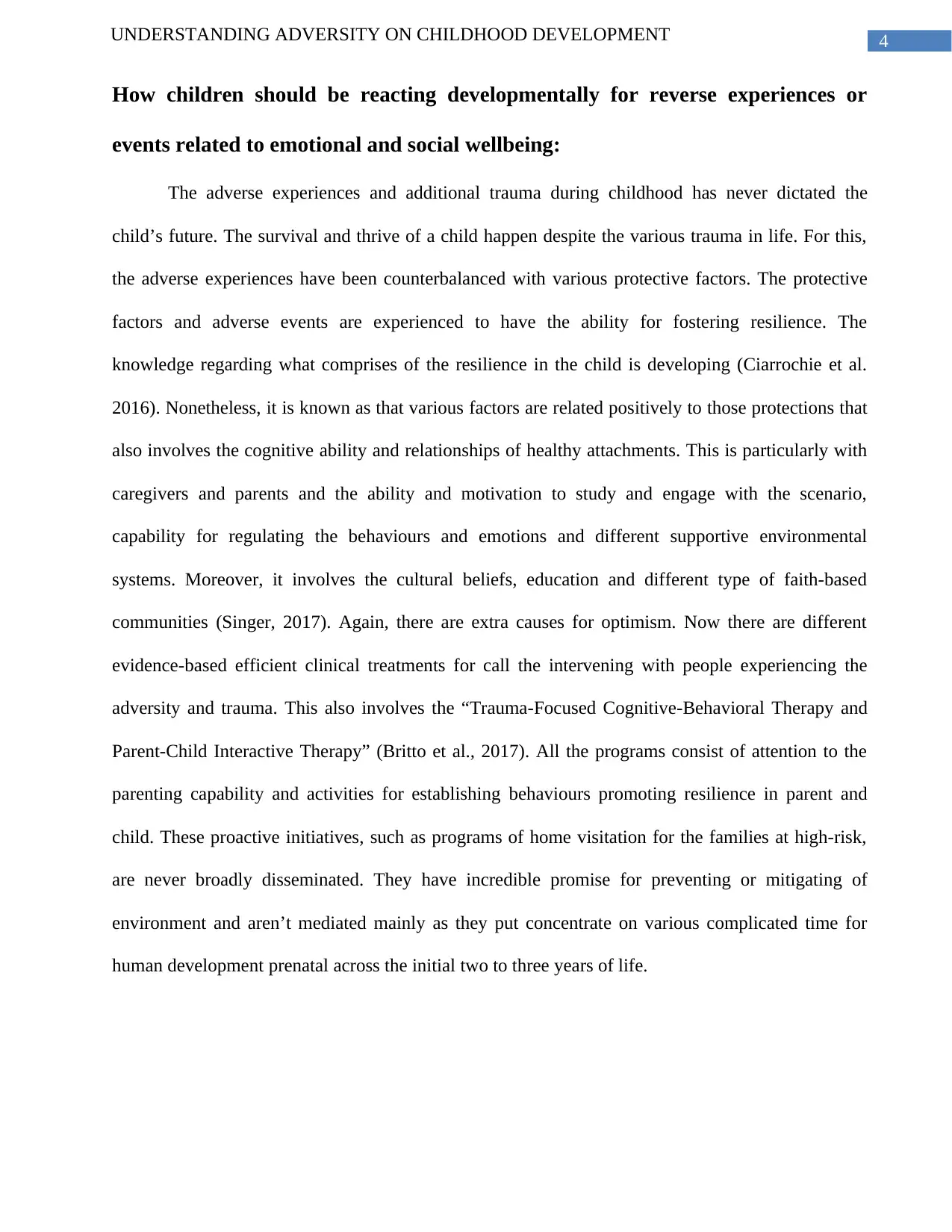
4UNDERSTANDING ADVERSITY ON CHILDHOOD DEVELOPMENT
How children should be reacting developmentally for reverse experiences or
events related to emotional and social wellbeing:
The adverse experiences and additional trauma during childhood has never dictated the
child’s future. The survival and thrive of a child happen despite the various trauma in life. For this,
the adverse experiences have been counterbalanced with various protective factors. The protective
factors and adverse events are experienced to have the ability for fostering resilience. The
knowledge regarding what comprises of the resilience in the child is developing (Ciarrochie et al.
2016). Nonetheless, it is known as that various factors are related positively to those protections that
also involves the cognitive ability and relationships of healthy attachments. This is particularly with
caregivers and parents and the ability and motivation to study and engage with the scenario,
capability for regulating the behaviours and emotions and different supportive environmental
systems. Moreover, it involves the cultural beliefs, education and different type of faith-based
communities (Singer, 2017). Again, there are extra causes for optimism. Now there are different
evidence-based efficient clinical treatments for call the intervening with people experiencing the
adversity and trauma. This also involves the “Trauma-Focused Cognitive-Behavioral Therapy and
Parent-Child Interactive Therapy” (Britto et al., 2017). All the programs consist of attention to the
parenting capability and activities for establishing behaviours promoting resilience in parent and
child. These proactive initiatives, such as programs of home visitation for the families at high-risk,
are never broadly disseminated. They have incredible promise for preventing or mitigating of
environment and aren’t mediated mainly as they put concentrate on various complicated time for
human development prenatal across the initial two to three years of life.
How children should be reacting developmentally for reverse experiences or
events related to emotional and social wellbeing:
The adverse experiences and additional trauma during childhood has never dictated the
child’s future. The survival and thrive of a child happen despite the various trauma in life. For this,
the adverse experiences have been counterbalanced with various protective factors. The protective
factors and adverse events are experienced to have the ability for fostering resilience. The
knowledge regarding what comprises of the resilience in the child is developing (Ciarrochie et al.
2016). Nonetheless, it is known as that various factors are related positively to those protections that
also involves the cognitive ability and relationships of healthy attachments. This is particularly with
caregivers and parents and the ability and motivation to study and engage with the scenario,
capability for regulating the behaviours and emotions and different supportive environmental
systems. Moreover, it involves the cultural beliefs, education and different type of faith-based
communities (Singer, 2017). Again, there are extra causes for optimism. Now there are different
evidence-based efficient clinical treatments for call the intervening with people experiencing the
adversity and trauma. This also involves the “Trauma-Focused Cognitive-Behavioral Therapy and
Parent-Child Interactive Therapy” (Britto et al., 2017). All the programs consist of attention to the
parenting capability and activities for establishing behaviours promoting resilience in parent and
child. These proactive initiatives, such as programs of home visitation for the families at high-risk,
are never broadly disseminated. They have incredible promise for preventing or mitigating of
environment and aren’t mediated mainly as they put concentrate on various complicated time for
human development prenatal across the initial two to three years of life.
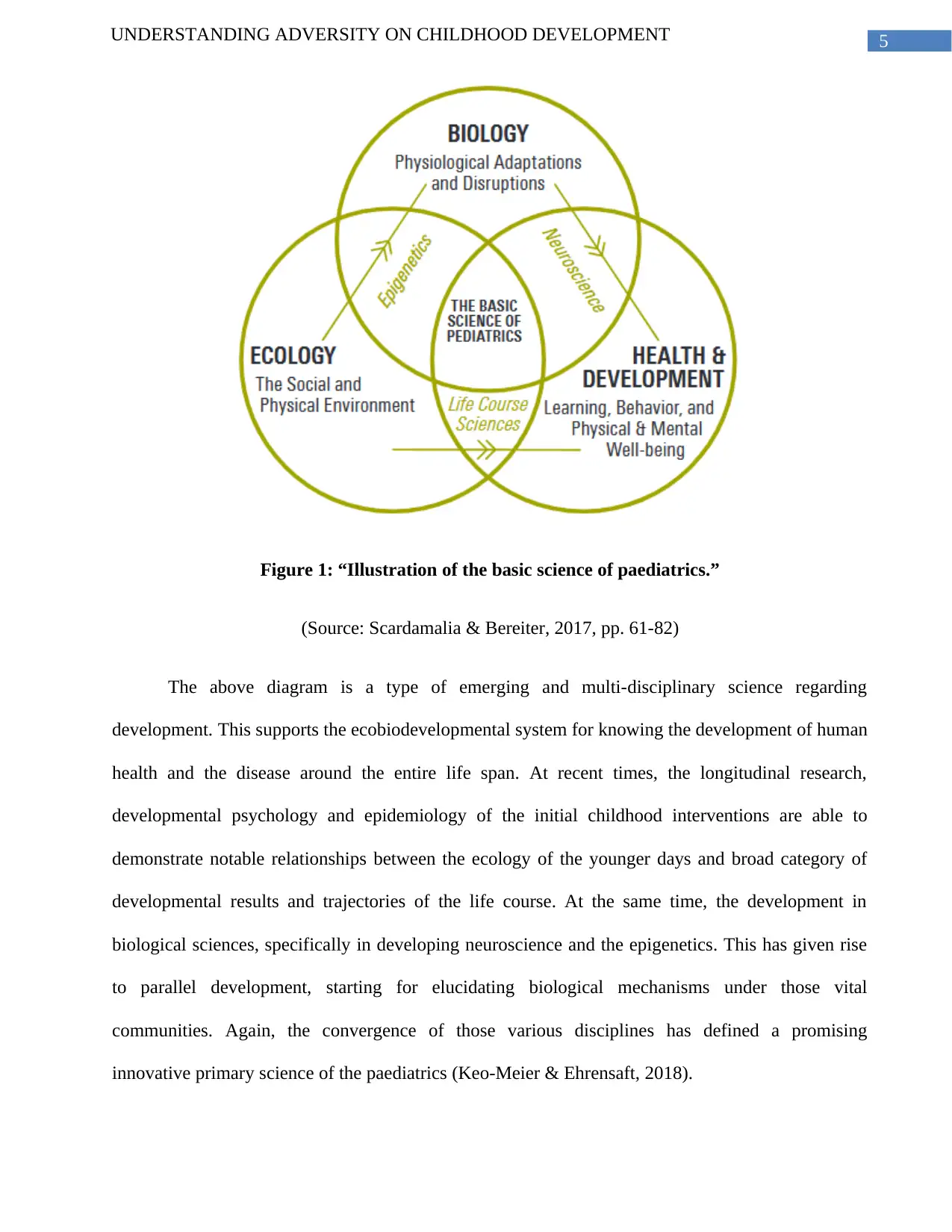
5UNDERSTANDING ADVERSITY ON CHILDHOOD DEVELOPMENT
Figure 1: “Illustration of the basic science of paediatrics.”
(Source: Scardamalia & Bereiter, 2017, pp. 61-82)
The above diagram is a type of emerging and multi-disciplinary science regarding
development. This supports the ecobiodevelopmental system for knowing the development of human
health and the disease around the entire life span. At recent times, the longitudinal research,
developmental psychology and epidemiology of the initial childhood interventions are able to
demonstrate notable relationships between the ecology of the younger days and broad category of
developmental results and trajectories of the life course. At the same time, the development in
biological sciences, specifically in developing neuroscience and the epigenetics. This has given rise
to parallel development, starting for elucidating biological mechanisms under those vital
communities. Again, the convergence of those various disciplines has defined a promising
innovative primary science of the paediatrics (Keo-Meier & Ehrensaft, 2018).
Figure 1: “Illustration of the basic science of paediatrics.”
(Source: Scardamalia & Bereiter, 2017, pp. 61-82)
The above diagram is a type of emerging and multi-disciplinary science regarding
development. This supports the ecobiodevelopmental system for knowing the development of human
health and the disease around the entire life span. At recent times, the longitudinal research,
developmental psychology and epidemiology of the initial childhood interventions are able to
demonstrate notable relationships between the ecology of the younger days and broad category of
developmental results and trajectories of the life course. At the same time, the development in
biological sciences, specifically in developing neuroscience and the epigenetics. This has given rise
to parallel development, starting for elucidating biological mechanisms under those vital
communities. Again, the convergence of those various disciplines has defined a promising
innovative primary science of the paediatrics (Keo-Meier & Ehrensaft, 2018).
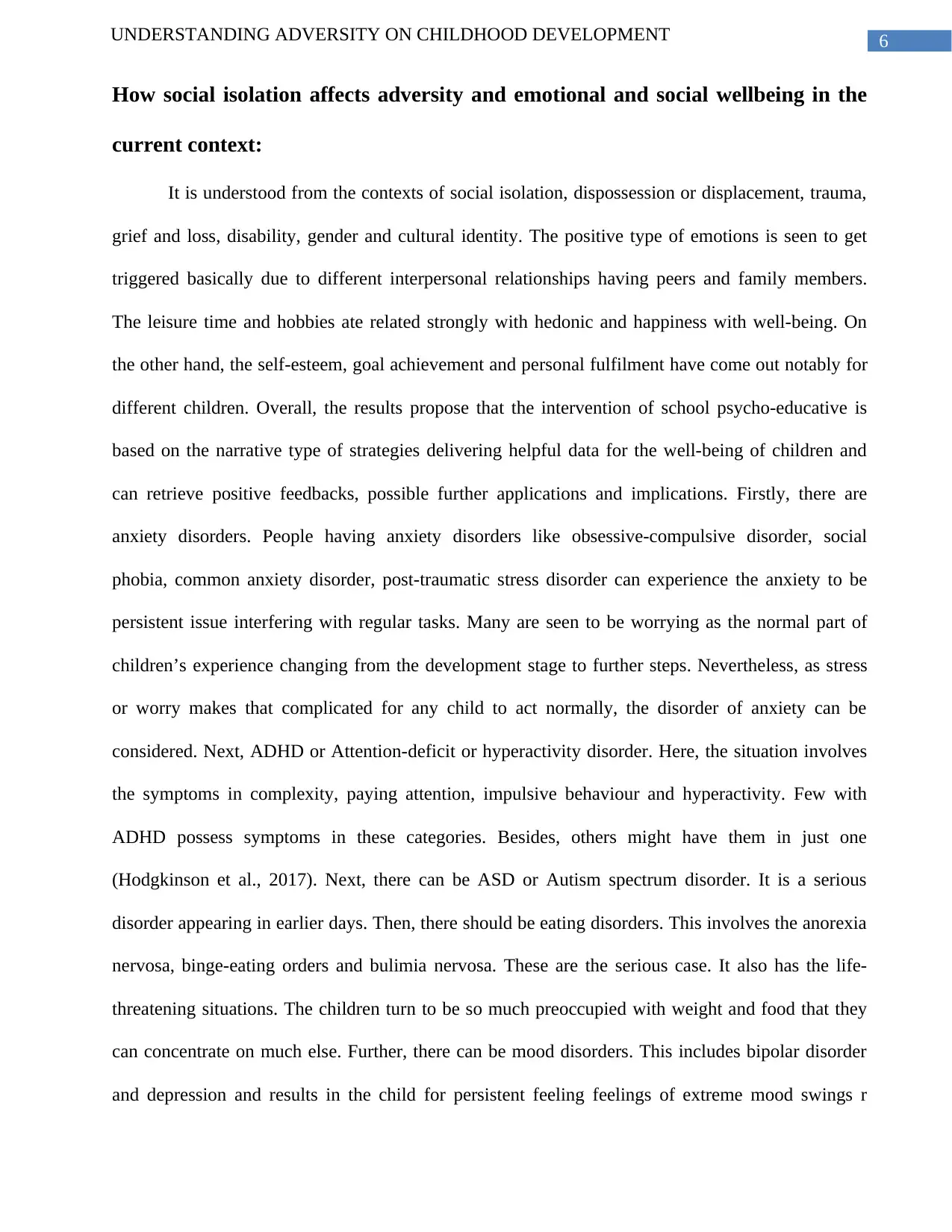
6UNDERSTANDING ADVERSITY ON CHILDHOOD DEVELOPMENT
How social isolation affects adversity and emotional and social wellbeing in the
current context:
It is understood from the contexts of social isolation, dispossession or displacement, trauma,
grief and loss, disability, gender and cultural identity. The positive type of emotions is seen to get
triggered basically due to different interpersonal relationships having peers and family members.
The leisure time and hobbies ate related strongly with hedonic and happiness with well-being. On
the other hand, the self-esteem, goal achievement and personal fulfilment have come out notably for
different children. Overall, the results propose that the intervention of school psycho-educative is
based on the narrative type of strategies delivering helpful data for the well-being of children and
can retrieve positive feedbacks, possible further applications and implications. Firstly, there are
anxiety disorders. People having anxiety disorders like obsessive-compulsive disorder, social
phobia, common anxiety disorder, post-traumatic stress disorder can experience the anxiety to be
persistent issue interfering with regular tasks. Many are seen to be worrying as the normal part of
children’s experience changing from the development stage to further steps. Nevertheless, as stress
or worry makes that complicated for any child to act normally, the disorder of anxiety can be
considered. Next, ADHD or Attention-deficit or hyperactivity disorder. Here, the situation involves
the symptoms in complexity, paying attention, impulsive behaviour and hyperactivity. Few with
ADHD possess symptoms in these categories. Besides, others might have them in just one
(Hodgkinson et al., 2017). Next, there can be ASD or Autism spectrum disorder. It is a serious
disorder appearing in earlier days. Then, there should be eating disorders. This involves the anorexia
nervosa, binge-eating orders and bulimia nervosa. These are the serious case. It also has the life-
threatening situations. The children turn to be so much preoccupied with weight and food that they
can concentrate on much else. Further, there can be mood disorders. This includes bipolar disorder
and depression and results in the child for persistent feeling feelings of extreme mood swings r
How social isolation affects adversity and emotional and social wellbeing in the
current context:
It is understood from the contexts of social isolation, dispossession or displacement, trauma,
grief and loss, disability, gender and cultural identity. The positive type of emotions is seen to get
triggered basically due to different interpersonal relationships having peers and family members.
The leisure time and hobbies ate related strongly with hedonic and happiness with well-being. On
the other hand, the self-esteem, goal achievement and personal fulfilment have come out notably for
different children. Overall, the results propose that the intervention of school psycho-educative is
based on the narrative type of strategies delivering helpful data for the well-being of children and
can retrieve positive feedbacks, possible further applications and implications. Firstly, there are
anxiety disorders. People having anxiety disorders like obsessive-compulsive disorder, social
phobia, common anxiety disorder, post-traumatic stress disorder can experience the anxiety to be
persistent issue interfering with regular tasks. Many are seen to be worrying as the normal part of
children’s experience changing from the development stage to further steps. Nevertheless, as stress
or worry makes that complicated for any child to act normally, the disorder of anxiety can be
considered. Next, ADHD or Attention-deficit or hyperactivity disorder. Here, the situation involves
the symptoms in complexity, paying attention, impulsive behaviour and hyperactivity. Few with
ADHD possess symptoms in these categories. Besides, others might have them in just one
(Hodgkinson et al., 2017). Next, there can be ASD or Autism spectrum disorder. It is a serious
disorder appearing in earlier days. Then, there should be eating disorders. This involves the anorexia
nervosa, binge-eating orders and bulimia nervosa. These are the serious case. It also has the life-
threatening situations. The children turn to be so much preoccupied with weight and food that they
can concentrate on much else. Further, there can be mood disorders. This includes bipolar disorder
and depression and results in the child for persistent feeling feelings of extreme mood swings r
Paraphrase This Document
Need a fresh take? Get an instant paraphrase of this document with our AI Paraphraser

7UNDERSTANDING ADVERSITY ON CHILDHOOD DEVELOPMENT
sadness that is more severe have common mood swings that are common in many. Lastly, there is
schizophrenia. It chronic mental sickness results to lose touch with reality. This mostly occurs in late
with the 20s (Cecil et al., 2017).
Practical instances of cases for demonstrating how the contexts can inform the
development of children:
Firstly, there may be anxiety disorders. This happens as the children worry lots and
frequently feel nervous or edgy. For example, it involves posttraumatic stress disorder and panic
disorders. Then there are mood disorders. Examples of this include depressive disorders and bipolar
disorders. Further, regarding psychotic disorders, schizophrenia is a kind of psychotic disorder
(Bridges, 2017).
Mental illness with children at many times is hard to be identified. Due to this, children who
can take benefits of treatments might get help as required. There are various common options for
treatment for children having mental health conditions. Firstly, psychotherapy is a good measure. It
helps learn how to react to different challenging situations having a good type of coping skills.
Secondly, there is the medication like stimulants, anti-anxiety, mood stabilizers, antidepressants,
antipsychotics and stimulants. Few can take advantage of the assimilation of the approaches. Prior a
child has been diagnosed with mental health situations, the children and parents experience the case
of helplessness. The mental health provider of the child must be asked for advice regarding the ways
for changing the methods of interactions with a child and also the ways of handling complex
behaviour. Further, one should search for ways to relax and have a fun time with the child. New
stress management techniques are to be searched for that should be helpful for understanding the
way to react to stressful cases calmly. One should seek the family counselling or helping the support
groups also. This is vital for the understanding of the illness and feelings also what one must do for
sadness that is more severe have common mood swings that are common in many. Lastly, there is
schizophrenia. It chronic mental sickness results to lose touch with reality. This mostly occurs in late
with the 20s (Cecil et al., 2017).
Practical instances of cases for demonstrating how the contexts can inform the
development of children:
Firstly, there may be anxiety disorders. This happens as the children worry lots and
frequently feel nervous or edgy. For example, it involves posttraumatic stress disorder and panic
disorders. Then there are mood disorders. Examples of this include depressive disorders and bipolar
disorders. Further, regarding psychotic disorders, schizophrenia is a kind of psychotic disorder
(Bridges, 2017).
Mental illness with children at many times is hard to be identified. Due to this, children who
can take benefits of treatments might get help as required. There are various common options for
treatment for children having mental health conditions. Firstly, psychotherapy is a good measure. It
helps learn how to react to different challenging situations having a good type of coping skills.
Secondly, there is the medication like stimulants, anti-anxiety, mood stabilizers, antidepressants,
antipsychotics and stimulants. Few can take advantage of the assimilation of the approaches. Prior a
child has been diagnosed with mental health situations, the children and parents experience the case
of helplessness. The mental health provider of the child must be asked for advice regarding the ways
for changing the methods of interactions with a child and also the ways of handling complex
behaviour. Further, one should search for ways to relax and have a fun time with the child. New
stress management techniques are to be searched for that should be helpful for understanding the
way to react to stressful cases calmly. One should seek the family counselling or helping the support
groups also. This is vital for the understanding of the illness and feelings also what one must do for
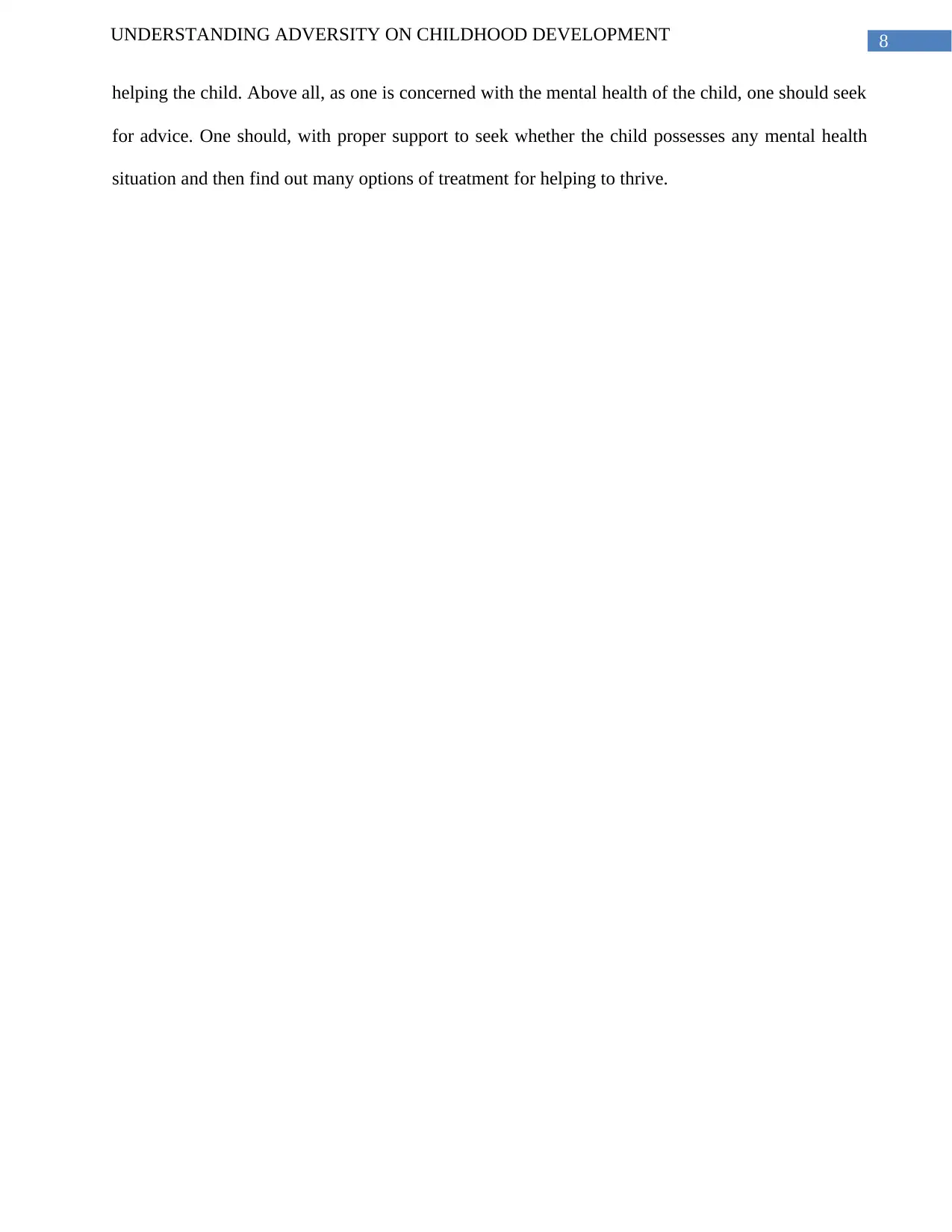
8UNDERSTANDING ADVERSITY ON CHILDHOOD DEVELOPMENT
helping the child. Above all, as one is concerned with the mental health of the child, one should seek
for advice. One should, with proper support to seek whether the child possesses any mental health
situation and then find out many options of treatment for helping to thrive.
helping the child. Above all, as one is concerned with the mental health of the child, one should seek
for advice. One should, with proper support to seek whether the child possesses any mental health
situation and then find out many options of treatment for helping to thrive.
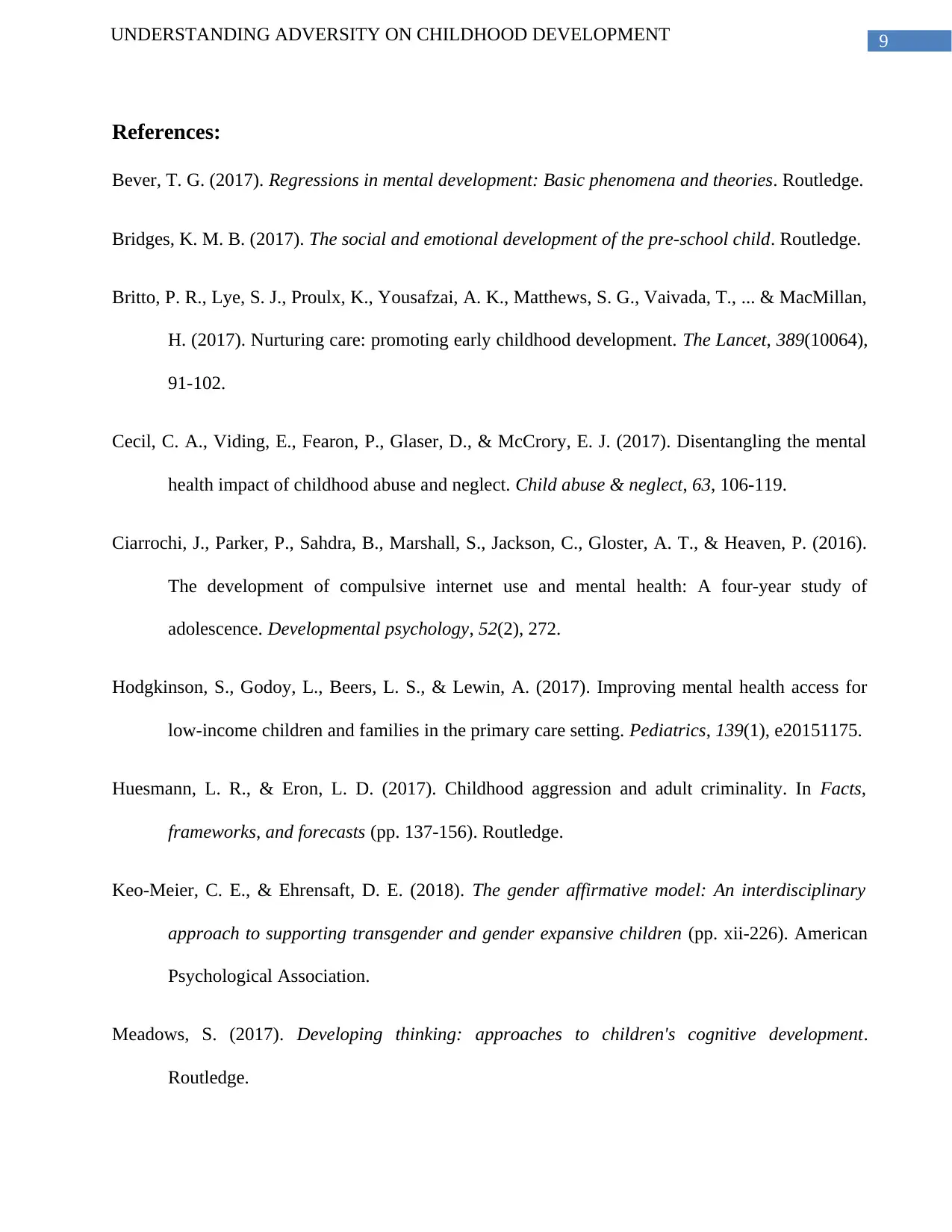
9UNDERSTANDING ADVERSITY ON CHILDHOOD DEVELOPMENT
References:
Bever, T. G. (2017). Regressions in mental development: Basic phenomena and theories. Routledge.
Bridges, K. M. B. (2017). The social and emotional development of the pre-school child. Routledge.
Britto, P. R., Lye, S. J., Proulx, K., Yousafzai, A. K., Matthews, S. G., Vaivada, T., ... & MacMillan,
H. (2017). Nurturing care: promoting early childhood development. The Lancet, 389(10064),
91-102.
Cecil, C. A., Viding, E., Fearon, P., Glaser, D., & McCrory, E. J. (2017). Disentangling the mental
health impact of childhood abuse and neglect. Child abuse & neglect, 63, 106-119.
Ciarrochi, J., Parker, P., Sahdra, B., Marshall, S., Jackson, C., Gloster, A. T., & Heaven, P. (2016).
The development of compulsive internet use and mental health: A four-year study of
adolescence. Developmental psychology, 52(2), 272.
Hodgkinson, S., Godoy, L., Beers, L. S., & Lewin, A. (2017). Improving mental health access for
low-income children and families in the primary care setting. Pediatrics, 139(1), e20151175.
Huesmann, L. R., & Eron, L. D. (2017). Childhood aggression and adult criminality. In Facts,
frameworks, and forecasts (pp. 137-156). Routledge.
Keo-Meier, C. E., & Ehrensaft, D. E. (2018). The gender affirmative model: An interdisciplinary
approach to supporting transgender and gender expansive children (pp. xii-226). American
Psychological Association.
Meadows, S. (2017). Developing thinking: approaches to children's cognitive development.
Routledge.
References:
Bever, T. G. (2017). Regressions in mental development: Basic phenomena and theories. Routledge.
Bridges, K. M. B. (2017). The social and emotional development of the pre-school child. Routledge.
Britto, P. R., Lye, S. J., Proulx, K., Yousafzai, A. K., Matthews, S. G., Vaivada, T., ... & MacMillan,
H. (2017). Nurturing care: promoting early childhood development. The Lancet, 389(10064),
91-102.
Cecil, C. A., Viding, E., Fearon, P., Glaser, D., & McCrory, E. J. (2017). Disentangling the mental
health impact of childhood abuse and neglect. Child abuse & neglect, 63, 106-119.
Ciarrochi, J., Parker, P., Sahdra, B., Marshall, S., Jackson, C., Gloster, A. T., & Heaven, P. (2016).
The development of compulsive internet use and mental health: A four-year study of
adolescence. Developmental psychology, 52(2), 272.
Hodgkinson, S., Godoy, L., Beers, L. S., & Lewin, A. (2017). Improving mental health access for
low-income children and families in the primary care setting. Pediatrics, 139(1), e20151175.
Huesmann, L. R., & Eron, L. D. (2017). Childhood aggression and adult criminality. In Facts,
frameworks, and forecasts (pp. 137-156). Routledge.
Keo-Meier, C. E., & Ehrensaft, D. E. (2018). The gender affirmative model: An interdisciplinary
approach to supporting transgender and gender expansive children (pp. xii-226). American
Psychological Association.
Meadows, S. (2017). Developing thinking: approaches to children's cognitive development.
Routledge.
Secure Best Marks with AI Grader
Need help grading? Try our AI Grader for instant feedback on your assignments.
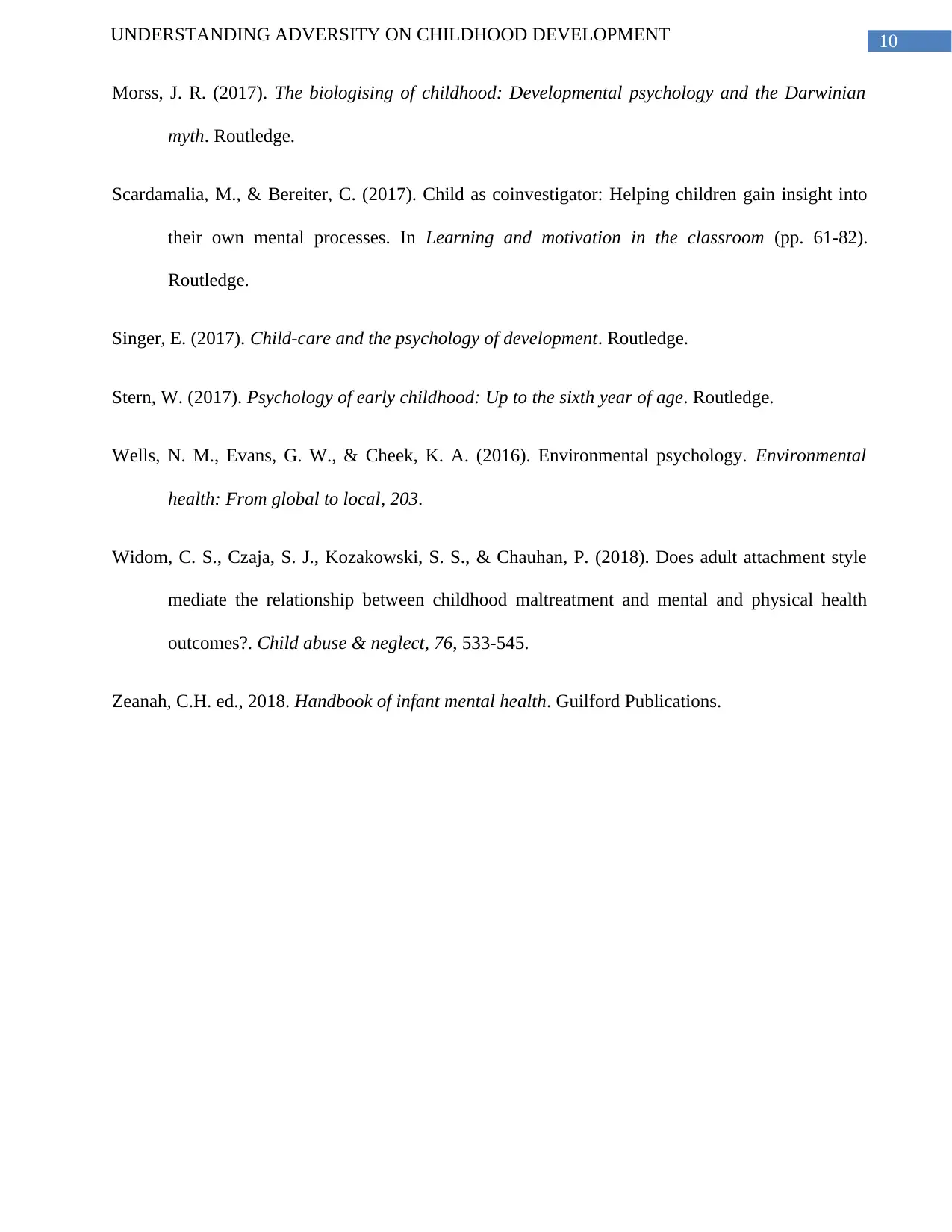
10UNDERSTANDING ADVERSITY ON CHILDHOOD DEVELOPMENT
Morss, J. R. (2017). The biologising of childhood: Developmental psychology and the Darwinian
myth. Routledge.
Scardamalia, M., & Bereiter, C. (2017). Child as coinvestigator: Helping children gain insight into
their own mental processes. In Learning and motivation in the classroom (pp. 61-82).
Routledge.
Singer, E. (2017). Child-care and the psychology of development. Routledge.
Stern, W. (2017). Psychology of early childhood: Up to the sixth year of age. Routledge.
Wells, N. M., Evans, G. W., & Cheek, K. A. (2016). Environmental psychology. Environmental
health: From global to local, 203.
Widom, C. S., Czaja, S. J., Kozakowski, S. S., & Chauhan, P. (2018). Does adult attachment style
mediate the relationship between childhood maltreatment and mental and physical health
outcomes?. Child abuse & neglect, 76, 533-545.
Zeanah, C.H. ed., 2018. Handbook of infant mental health. Guilford Publications.
Morss, J. R. (2017). The biologising of childhood: Developmental psychology and the Darwinian
myth. Routledge.
Scardamalia, M., & Bereiter, C. (2017). Child as coinvestigator: Helping children gain insight into
their own mental processes. In Learning and motivation in the classroom (pp. 61-82).
Routledge.
Singer, E. (2017). Child-care and the psychology of development. Routledge.
Stern, W. (2017). Psychology of early childhood: Up to the sixth year of age. Routledge.
Wells, N. M., Evans, G. W., & Cheek, K. A. (2016). Environmental psychology. Environmental
health: From global to local, 203.
Widom, C. S., Czaja, S. J., Kozakowski, S. S., & Chauhan, P. (2018). Does adult attachment style
mediate the relationship between childhood maltreatment and mental and physical health
outcomes?. Child abuse & neglect, 76, 533-545.
Zeanah, C.H. ed., 2018. Handbook of infant mental health. Guilford Publications.
1 out of 11
Related Documents
Your All-in-One AI-Powered Toolkit for Academic Success.
+13062052269
info@desklib.com
Available 24*7 on WhatsApp / Email
![[object Object]](/_next/static/media/star-bottom.7253800d.svg)
Unlock your academic potential
© 2024 | Zucol Services PVT LTD | All rights reserved.





